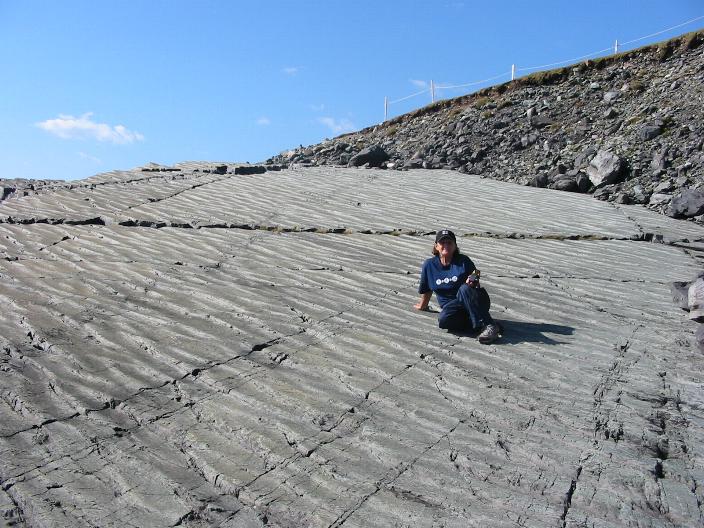History
In the summer of 1967, S.B.Misra an Indian graduate student
(1966 - 69) from Newfoundland's Memorial University discovered a
rich asssemblage of imprints of soft bodied organisms on the
surface of large rock slabs in the Conception Group of Avalon
Peninsula of Newfoundland near Cape Race, at a place called
Mistaken Point.
These unusual impressions of previously unknown soft-bodied sea
animals on the surfaces of argillites (mudstone) included
coelenterates and other metazoa of the ediacarian age ie. more than
560 million years old. Misra made the discovery during the course
of geological mapping of the previously unmapped area of
southeastern part of the Avelon Peninsula of Newfoundland.
Mistaken Point fossil impressions can be found on the surface of
large rock slabs. The area includes 2.5 sq km of coastline
containing possibly the oldest metazoan impressions in the western
hemisphere of marine creatures that lived more than 560 million
years ago. These impressions also represent some of the most varied
and well preserved ezamples of Precambrian fossils in the
world.
ECT Hikers at Mistaken
Point

The fossil found at Mistaken Point fall into four groups
namely:
1. Spindle-shaped forms
2. Leaf-shaped forms
3. Round lobate forms
4. Radiating forms
Spindle-shaped organisms
Spindle -shaped impressions are the most common of all the fossil
types and have wide distribution throughout the locality. They are
elongate in shape and are thinner at the ends. They have a
bilateral symmetry with a median axis that runs along the entire
length of the fossil. The median in some cases is straight,while in
others it is zig zag. The length of the Spindle-shaped forms is
variable, ranging in most cases from 3cm to 30 cm. All are
preserved in their entirety and some impressions exhibit a definite
outline. Regardless of size, all contain lateral branches from the
median axis, which are divided and sub-divided.
Leaf-shaped
Impressions
These are second in abundance to the Spindle-shaped animals. The
fossils are oriented roughly in the direction of turbidity currents
with the main part of their body always falling in the direction of
flow, i. e. in a southward direction. The fossil impressions are
thought to represent a colony of a Metazoan. The fossil consists of
three parts, a main body having a leaf-shaped structure with a
terminal needle-shaped projection, a stalk, and a round base
attached to the stalk. The main body is somewhat round divided by
branches, and imprints exhibit a definite outline. The form is
considered as an imprint of a new floating colonial Hydrozoan and
the disc shaped round base is probably a float or medusa. An
alternative explanation is that the disc shaped base represents a
hold-fast and the main body of the animal was supported on a stalk
attached to the base with the long needle like projection upward.
Round Lobate
Forms
These fossils resemble Jelly fish in shape and outline but do not
seem to correspond to any of the recent forms. Two types are
distinguishable; the first is a well defined round lobate fossil
while the second appears like a net in some forms but has distinct
lobate structure in the other forms An alternative explanation of
these objects is that the round lobate forms are floats or Medusae
as suggested by the base of the Leaf-shaped objects, yet the base
of the Leaf-shaped objects do not show a lobate or any such
structure.
Radiating
Forms
The fossils are thought to represent as colony of animals rather
than a single individual. In arrangement, their needles like bodies
diverge from a point where they were joined to one another. The
fossils are not abundant but are found on the entire fossil bearing
horizons in the locality. The fossils may be impressions of
Spindle-shaped animals in a different preservation. However, it is
also probable that the animals were attached to mud at the point of
convergence from where their elongate bodies diverged upward.
To get credit
for the EarthCache please complete the following
task:
1.When you reach the posted cords look for a fossil.
2.Find out what class (out of the four listed above) the fossil
best fits into.
3.Measure the width and length of the fossil you choose.
4.Send me(by email) the info from task 2 & 3.
To Prove you
where there please take a picture beside a plaque on the way to
Mistaken Point fossil area it's on the trail and a picture of your
GPS beside the fossil post them in your log.
You do not need to wait for confirmiation from me before posting
online. However, any logs that do not fulfill ALL
requirements will be deleted.